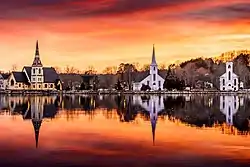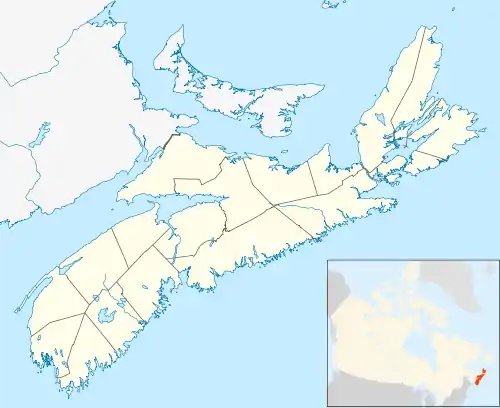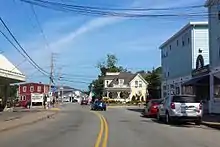Mahone Bay, Nova Scotia
Mahone Bay is a town on the northwest shore of Mahone Bay along the South Shore of Nova Scotia in Lunenburg County. A long standing picturesque tourism destination, the town has recently enjoyed a growing reputation as a haven for entrepreneurs and business startups.[3] The town has the fastest growing population of any municipality in Nova Scotia according to the 2016 census, experiencing 9.9% population growth.[4]
Mahone Bay | |
|---|---|
Town | |
 The Famous Three Churches of Mahone Bay | |
Seal | |
| Motto(s): "A Treasure Since 1754" | |
 Mahone Bay Location within Nova Scotia | |
| Coordinates: 44°26′56″N 64°22′55″W | |
| Country | |
| Province | |
| County | Lunenburg County |
| Founded | 1754 |
| Incorporated | March 31, 1919 |
| Government | |
| • Mayor | David Devenne[1] |
| • Governing Body | Mahone Bay Town Council |
| • MLA | Suzanne Lohnes-Croft Liberal |
| • MP | Bernadette Jordan (L) |
| Area (2016)[2] | |
| • Total | 3.12 km2 (1.20 sq mi) |
| Highest elevation | 24 m (79 ft) |
| Lowest elevation | 0 m (0 ft) |
| Population | |
| • Total | 1,036 |
| • Density | 332.1/km2 (860/sq mi) |
| Time zone | UTC-4 (AST) |
| Postal code span | B0J |
| Area code(s) | 902 |
| Telephone Exchanges | 521, 624, 627 |
| Median household income (2005) | $36,374 |
| Total private dwellings | 571 |
| Website | townofmahonebay.ca |
History
"The Town of Mahone Bay is part of the Mi’kma’ki territory of the Mi’kmaq who have inhabited their traditional lands for over 13,500 years. Prior to arrival of the Europeans, Mi’kmaw lived in and around what is now Mahone Bay. Indian Point, just outside the town, was an important summertime settlement where the Mi’kmaq could enjoy the sheltered waters and plentiful food sources. In the winter, they would move inland from the coast using the rivers that flow into Mahone Bay harbour. There are many Mi’kmaq who live in the area today.
Msit no’kmaq is a Mi’kmaw construct which roughly translates into “All My Relations.” Msit no’kmaq speaks to the relational interconnectedness between every human being and all forms of life and is one of the reasons that early settlers were welcomed when they arrived in Mi’kma’ki.
EUROPEAN SETTLEMENT
During their early encounters with the French, the Mi’kmaq traded animal furs and pelts for manufactured goods. This, as well as the Mi’kmaw belief that no one, not even them, owned the land, led to an alliance between the Mi’kmaq and the French, which resulted in the French Acadians settling the area (which they called Acadie) in 1605. Acadie incorporated many parts of Mi’kma’ki which today are known as Nova Scotia, PEI, as well as most of New Brunswick. However, this all changed with the Treaty of Utrecht in 1713, wherein the French granted possession of most of Acadie, land that was not theirs to grant, to the British.
To attempt to keep control of the land, the British government decided to develop a new naval centre for the colony in Halifax. In these discussions, little or no thought was given to the concerns of the Indigenous Peoples living in this region and it wasn’t long before the Mi’kmaq regarded the founding of Halifax, without their consent, as a breach of the terms of the “Treaties of Peace and Friendship” they had signed with the British Crown in 1725. However, the British continued to expand in order to support their new naval establishment at Halifax.
They recruited protestant farming settlers from Europe, starting in 1750, to counter the existing Mi’kmaq and French Acadian Catholic population.
British officials placed public notices in Germany, southern France, Switzerland, and the Netherlands stating that those willing to move to their planned settlement in Nova Scotia would receive grants of land, food for a year, and a few farm animals. Between 1750 and 1752 more than 2,200 such “Foreign Protestants” made the long journey from Europe to Halifax. To view the list of these settler families, visit https://mahonebaymuseum.com/research/settler-families-of-mahone-bay/
In 1753, most of the new immigrants were brought from Halifax to Lunenburg, which was to be the centre of the planned settlement. Mills were established at the mouth of each of Mahone Bay’s two rivers and over the decades a separate community evolved at Mahone Bay with blacksmiths, merchants, a large school, churches, and shipyards.
In the early days of the colonization of Mahone Bay, the Mi’kmaq and the British Crown signed various Peace and Friendship Treaties. The purpose of these treaties was to outline solemn agreements that set out long-standing promises, mutual obligations and benefits between the Mi’kmaq, the British crown and settlers, so that everyone living in Mi’kma’ki could live peacefully together. Even today, the source of the Town of Mahone Bay’s authority over land remains connected to the Peace and Friendship treaties that were signed with the British over 250 years ago.
SHIPBUILDING
Mahone Bay’s boat building history begins with the Mi’kmaq. The Mi’kmaq were very skilled at building birch bark canoes and had been living in this area for over thirteen thousand years before Mahone Bay and Lunenburg were settled in 1753-1754 by “British Subjects” mostly from France, Germany, Switzerland, and the Netherlands. [...]The British claimed this land as theirs and this particular area was ideal for sawmills due to vast amounts of timber and the two rivers emptying into the bay, which made for easy transport of logs to the sawmills. These sawmills established by the early settlers produced first-rate lumber for shipbuilding.
The earliest official registration form found for a vessel built in Mahone Bay dates from 1817. By 1850, at least 43 vessels had already been built by small shipyards in the Mahone Bay area and larger shipyards began being established to build mainly schooners and other smaller vessels, primarily for fishing and moving goods. As years passed, the trend was to build larger vessels for longer distance trading with the United States, West Indies, and elsewhere.
By the end of WWI, there was no longer much demand for sailing vessels so the local shipyards began designing and building power vessels that used engines instead of sails for fishing and moving goods (including rum-running). Shipyards continued producing vessels during WWII. During this period, as many as 500 people were employed in Mahone Bay shipyards.
Although fishing vessels were still being built until 1967, after WWII the industry transitioned to mainly constructing pleasure boats. Fibreglass sailboats were built on the site of the present RPS Composites factory located at 740 Main Street, under several different company names, including Paceship Yachts. The final days of commercial boat building concentrated on the building of pleasure crafts. Mahone Bay Plycraft Co.
built thousands of laminated plywood “runabout” boats from 1949-1962. Commercial shipbuilding in the Town of Mahone Bay wrapped up around 1975, when the last fibreglass yachts were built at Paceship.
Below is a short description of the six major shipyards producing many large vessels that were active in the Mahone Bay area between 1850 – 1942.
OBED H. HAM YACHT WORKS
In 1901, Obed Ham established his shipyard on Main Street, just down the harbour from the Ernst yard. The yard focused on the design and production of custom-built pleasure craft, ranging from a 16-foot catboat to a 128-foot yacht. Ham retired in 1932 after building over 400 vessels. Obed Ham, written up in his time as “the genius of Mahone”, was Nova Scotia’s first builder of pleasure yachts, a trend that continued in Mahone Bay until 1975 when Paceship Yachts closed.
ABRAHAM ERNST/ERNST & SONS/ERNST SHIPBUILDING
Abraham Ernst’s first recorded ship was built in 1888. His shipyard was located near the corner of the Fauxburg Road and Main Street in front of where the RPS Composites factory is today. Primarily building vessels for the fisheries and cargo, including some designed specifically for rum-running, the yard operated until 1942, during which time it built at least 100 ships.
JOHN H. ZWICKER
John Zwicker, brother of Elkanah, began operation in 1862, in a location adjacent to the present-day town wharf. It is claimed that the yard built a total of 148 vessels, however to date only 51 registration forms have been found for vessels built by John H. Zwicker. One of his vessels was said to be the largest ever constructed in Mahone Bay, the 1200 ton (183 feet) full-rigged ship Kinburn, in 1873. The yard closed in 1906 and was purchased by John McLean in 1917.
JOHN MCLEAN AND SONS SHIPYARD
John McLean established his yard in 1865 (however, registrations for vessels have only been found starting in 1900). It was located between Maders Wharf and the presentday town wharf. John McLean earned his master shipbuilder credentials at the age of 21. Upon John’s death in 1910, his sons carried on the business, expanding by buying the John H. Zwicker yard in 1917, and went on to build 74 ships until 1959.
ELKANAH ZWICKER/TITUS LANGILLE
The first commercial shipyard in Mahone Bay was established in 1850 by Elkanah Zwicker and sold in 1862 to Titus Langille. Between 1866 and 1889, Langille built 22 vessels. The shipyard was located near the Michael O’Connor Memorial Bandstand on Main Street near the parking lot of the Independent grocery store.
HENRY SCHNARE
Founded in 1884, Henry Schnare’s yard was located on the harbour between the St. James Anglican and St. John’s Lutheran churches. A relatively small operation, it produced approximately 24 vessels from 1888 to 1911, ranging from 22 to 100 tons (approx. 50 to 90 feet long). The ships had to be launched laid over on their sides due to the shallow waters
of the Bay."[5]
Today

The town is also known for a history of wooden boat building, it was the main industry of Mahone Bay in its earlier years. The Mahone Bay Museum explains and shows this history in detail. Until recent years the town's shipbuilding and boat-building heritage was celebrated by the "Mahone Bay Wooden Boat Festival".
The view across the harbour is of three prominent churches: St James' Anglican; St John's Evangelical Lutheran; and Trinity United. It has become an iconic image of Nova Scotia, frequently photographed and featured on postcards and calendars.[6] The town has a number of upscale shops and restaurants which almost universally are designed to appeal to the tourist trade, and sometimes shut down during the winter months. The town also has a plastics factory.
Demographics
In the 2016 Census of Population conducted by Statistics Canada, the Town of Mahone Bay recorded a population of 1,036 living in 501 of its 571 total private dwellings, a change of 9.9% from its 2011 population of 943. With a land area of 3.12 km2 (1.20 sq mi), it had a population density of 332.1/km2 (860.0/sq mi) in 2016.[2]
Government
The Town of Mahone Bay is governed by a Council composed of a Mayor and six Councillors elected at-large. [12] The mayor is David DeVenne.[13] Day to day activities are managed by a Chief Administrative Officer (CAO) who is accountable to Council.[14] Municipal governments in Nova Scotia are elected every four years and the most recent round of elections took place on October 15, 2016.[15] The provincial legislation that creates and empowers the municipality is the Nova Scotia Municipal Government Act.[16]
Municipal Council is responsible for all facets of the municipal government, including directly delivered and shared or regional services. Directly delivered services include services such fire, public works, roads, as well as the municipally owned and operated electrical and water utilities. The municipality participates in shared services, such as library services and policing. The town's municipal operating budget was $2.7 million, and the town owned electric light utility of $1.9 million and water utility of $575 thousand resulted in a total proposed budget of $5.2 million in the 2017/18 fiscal year.[17]
Mahone Bay is represented by one riding in the Nova Scotia House of Assembly and shares representation with one riding in Canada's House of Commons.
References
- Mayor's Welcome - Town of Mahone Bay
- "Population and dwelling counts, for Canada, provinces and territories, and census subdivisions (municipalities), 2016 and 2011 censuses – 100% data (Nova Scotia)". Statistics Canada. February 8, 2017. Retrieved February 12, 2017.
- "Mahone Bay, Shelburne, Bridgewater are the little towns that could". Chronicle Herald. Saltwire Publishing. Retrieved 31 March 2018.
- "Census Profile, 2016 Census Mahone Bay, Town [Census subdivision]". Statistics Canada. Government of Canada. Retrieved 31 March 2018.
- "Mahone Bay Museum Our Town's History". mahonebaymuseum.com. Retrieved 2021-01-20.
- Pacey, Elizabeth; Comiter, Alvin (1994). Landmarks: Historic Buildings in Nova Scotia. Nimbus Publishing. p. 74. ISBN 978-1-55109-071-9.
- , Censuses 1871-1931
- , Census 1941-1951
- Census 1951-1961
- , Census 1961
- Archived 2013-10-05 at the Wayback Machine, Censuses 1981-2001
- "Town Government". Town of Mahone Bay. Town of Mahone Bay. Retrieved 31 March 2018.
- "Mayor's Welcome". Town of Mahone Bay. Town of Mahone Bay. Retrieved 31 March 2018.
- "Town Government". Town of Mahone Bay. Town of Mahone Bay. Retrieved 31 March 2018.
- "Here are all the mayors elected in Nova Scotia's municipal election | CBC News".
- https://nslegislature.ca/sites/default/files/legc/statutes/municipal%20government.pdf "Municipal Government Act"
- "Proposed 2017/18 Operating Budget". Town of Mahone Bay. Town of Mahone Bay. Retrieved 31 March 2018.
External links
| Wikimedia Commons has media related to Mahone Bay, Nova Scotia. |